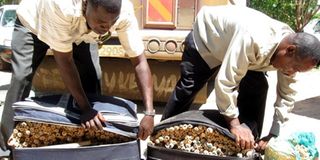How drug dealers evade police and customs dragnet

Anti-narcotics officers display suitcases loaded with bhang. A report gives an example of the 1.25 metric tonnes of cocaine that was seized in 2004, which was transported to Nairobi and back to Mombasa after being packaged into smaller bundles that were labelled as industrial roofing tiles. Photo/FILE
Narcotics imported into the country are disguised as general use commodities such as clothes, wine, car parts and spices to beat police and customs dragnets at the port of Mombasa.
Hotels, supermarkets and car dealerships are some of the businesses that are used as front companies for narcotics trafficking by the drug dealers.
This is according to a dossier prepared by the American embassy on drug trade in Kenya.
The dossier implicates five individuals — four MPs including an assistant minister and a prominent Mombasa businessman.
The report gives an example of the 1.25 metric tonnes of cocaine that was seized in 2004, which was transported to Nairobi and back to Mombasa after being packaged into smaller bundles that were labelled as industrial roofing tiles.
In October 2008, one of the suspected drug traffickers was involved in a suspicious shipment disguised as containing 500 cartons of shoes.
Other shipments are disguised as ceramic tiles, aluminium doors and locks, candles and clothing.
In December 2007, one of the alleged drug lords reportedly imported used computers from Latin America suspected to contain cocaine.
When such containers are seized by police or customs officials, the traffickers allegedly pay millions of shillings in bribes to have them released or silence the officials. One such incident is cited as having occurred in October 2008.
The dossier says that one of the two containers of used clothes was held, but the importer paid a Sh1 million bribe to have the customs officer who had taken action replaced.
Unspecified narcotics
In July 2008, one of the suspected drug kingpins allegedly received “unspecified narcotics from Pakistan, Dubai and Tanzania which he stored in Gikomba, Mathare and Githurai.”
The dossier alleges that the crew of his public transport vehicle fleet were used to distribute the drugs in Nairobi’s Buruburu estate and the CBD.
The same suspect is said to have previously used a location near the Eastleigh Air Force base in Nairobi as a processing and packaging facility.
Heroin, the dossier claims, was brought into the base by couriers where it was packaged and shipped out in military vehicles to other distribution sites.




